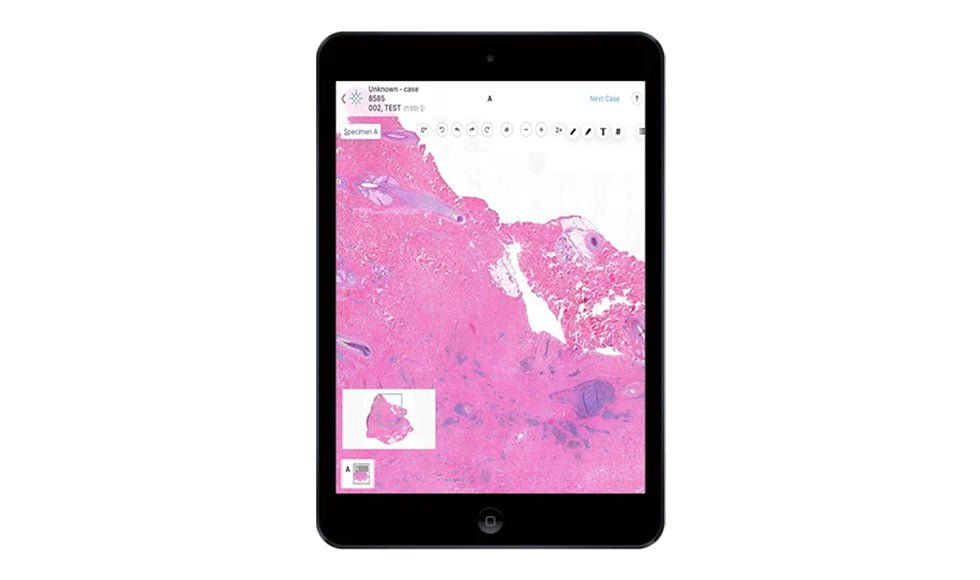Images shown are not intended to be used for the diagnosis or treatment of a disease or condition.
Digital pathology services are expected to grow roughly 8 percent in 2021 as a result of the growing demand for its use due to COVID-19. One survey of 261 people in the pathology industry found that between 72 and 90 percent of respondents believe that the use of digital pathology education tools will remain the same or increase moving forward.
The advancement of digital pathology services has streamlined the workflow process, changing the field of dermatopathology for the better. Though there are multiple benefits to using digital pathology, we’re going to examine the most prominent potential benefits, including modernized access, better opportunities for collaboration, and improved patient care.
Modernized Access
Though digital pathology provides a number of benefits, the technology is still relatively new in the field. The Food and Drug Administration authorized the first whole-slide imaging device in the United States in 2017, followed by a second system in 2019, allowing for collected skin, hair, and nail tissue samples to be digitized.
After a sample has been digitized, dermatopathologists can analyze and pass along their findings digitally. Depending on the severity of the patient’s condition, this access can play an important part in delivering timely treatment or management options to patients.
With cases and slides organized in the digital slide viewer, like the one offered by PathologyWatch, dermatopathologists can review specimens and generate reports of their findings possibly more efficiently than traditional microscopy. Unlike handling glass slides, whole-slide images are available any place and any time with an internet connection.
Dermatology practices also benefit from digital pathology. EMR integration means less paperwork, which can reduce hand-written errors and lighten staff burdens. Additionally, dermatologists can pull up digital slides thanks to improved access when explaining a diagnosis to a patient in order to help answer their questions.
Better Collaborative Opportunities
In the same vein as the improved accessibility, digitized slides can also be shared with colleagues more easily, potentially allowing for more collaboration between dermatopathologists. If a second opinion is required to confirm a particular condition, digital pathology can help dermatopathologists to share virtual slides with specialists anywhere in the world in an instant. In the past, this process would have required packaging, labeling, and mailing a sample to a lab, where it would then need to be received, processed, and distributed to another dermatopathologist, which could have taken days or even weeks.
Because dermatopathologists generate digital reports detailing their interpretation of samples, this ability to collaborate more effectively allows for specialists to better ensure an accurate diagnosis. Digital samples can also be compared to catalogs of previous historical data, which can be linked in the dermatopathologist’s report as evidence to support their findings.
Improved Patient Care
Building on the first two points, the improved accessibility and greater opportunity for collaboration through digital pathology may ultimately provide better patient care. According to the National Center for Biotechnology Information, when a pathologist is able to engage directly with the treating clinician, they can reduce days of unnecessary waiting in sending their report, increasing the chances of determining an effective treatment plan for the patient. Digital pathology can bridge this gap, allowing a pathologist to make their analysis and possibly report it more efficiently.
When a patient hears that additional testing is needed, they may start to worry. In fact, in a 2020 report from the Emergency Care Research Institute, the number one concern among patients was an incorrect or delayed diagnosis, so it’s important to work both quickly and effectively to help alleviate the patient’s concerns. In the event that a dermatopathologist’s findings suggest a more intensive course of treatment, the ability to receive that information faster can potentially help a dermatologist get the patient started on their treatment regimen more quickly.
The benefits of using digital pathology services stretch well beyond this list, but now you have some idea of how it allows for better collaboration through modernized access, ultimately improving the overall patient experience. Contact PathologyWatch to learn more about how we can help you begin the process.

